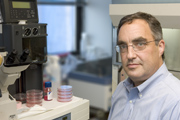How You Can Become Part of the Revolution in Heart Care
Private support is crucial to the ongoing research at the Center for Molecular Cardiology. As our extraordinary research facility grows, we need to perpetually renovate and improve our laboratories, recruit new researchers, and provide fellowships for young scientists, among many other things.
Contributions in any amount help us continue our work, whether a small personal contribution, a memorial gift, or a significant grant. Opportunities for naming are still available.
Some 64 million Americans with cardiovascular disease stand to benefit from the groundbreaking discoveries you can read about in this newsletter. It may seem a long way from the laboratory bench to the bedside, but the intent of translational medicine is to shorten that distance. Every successful step we make in heart research today could very well benefit you or someone you love tomorrow.
A Special Message from the Director |
 |
|---|
Here at Columbia University Medical Center, we’ve begun a revolution in the treatment of heart disease, the number one killer in the United States and Europe. Like every revolution, ours started with ideas. One idea is that we can address the root causes of cardiovascular disorders through sophisticated bench science created by new insights from the human genome. Another is that working together, rather than in isolation, our top-ranked scientists can make greater progress faster. And a third is that if we marry the most advanced research to the best in clinical treatments, our patients can benefit sooner from our laboratory findings. We call this medicine, founded on the bedrock of bench science, translational.
Thanks to the generous beyond measure gift of Clyde Wu, M.D., and his wife, Helen, we have established the Wu Center of Molecular Cardiology at Columbia and are beginning to attract impressive new talent. In this issue of Heart Horizons, you can read about our recent recruit, Henry Colecraft, Ph.D., an outstanding biophysicist who studies calcium and potassium channels in the heart.

